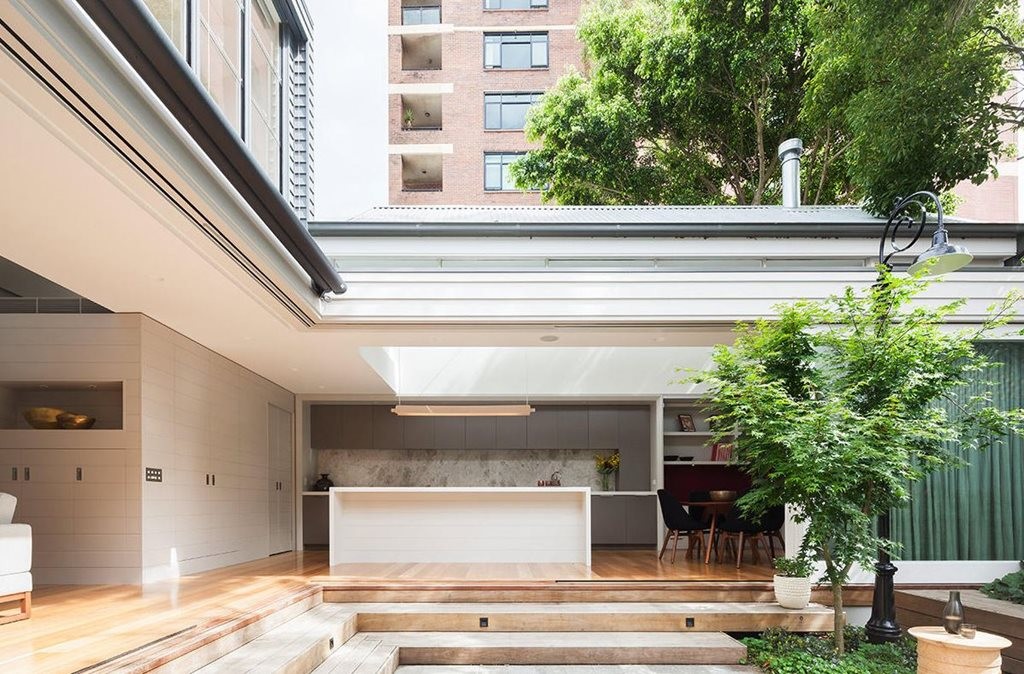A small sculptural roof addition to an 1860s-built weatherboard cottage shows how small details can make a world of difference to both the external and internal experience of a home.
The new roof forms part of an extensive renovation to a heritage listed residence in Newtown, Sydney and extends from the cottage’s original hip roof to provide more space for the project’s internal attic conversion.
From street view, the alteration to ‘Hurlstone House’ by Tanner Kibble Denton Architects (TKD) is invisible, and the Victorian charm of the property strictly maintained. Inside is a different story, and while TKD did make explicit reference to the personality of the original property, the interior space is a contemporary upgrade by all accounts.
 Rear-exterior view.
Rear-exterior view.  Street view
Street view
While TKD’s interior fitout is striking, and has all the bells and whistles of a brand new home, Hurlstone House’s most noticeable feature from the exterior-rear is the new blue-clad sculptured roof that could, at a bit of a stretch, be seen to reference the original dormer windows at the front of the building.
 The old home’s weatherboard walls have now become the feature walls for the interior and marry the architectural styles of the different time periods. A vintage rotary dial telephone, and the stained glass windows also reference the home’s Victorian heritage.
The old home’s weatherboard walls have now become the feature walls for the interior and marry the architectural styles of the different time periods. A vintage rotary dial telephone, and the stained glass windows also reference the home’s Victorian heritage. 
The roof is clad in Novelis Aluluminium in a dark Mattgraudunkel colour and expands 4.2m outwards from a 2.2m-wide junction with the rear fall on the existing hip roof. The entire roof rises only a slight 0.6m so as to remain concealed from the street but is also countersunk 0.3m below the fascia at the junction point, affording a bit more space inside.
Both the standing seam profile of the roof and its colour were selected by the architects for specific reasons. The seam profile, although vertically aligned, continues the linear-cladding theme of the home and marries the new addition to the old building. The Mattgraudunkel colour, although completely contrasting to the whiteness of the rest of the home, was chosen by the architects so the new addition would recede into the broader context and allows the roof to blend with the blue sky behind.
 Construction photos courtesy of The Copper & Zinc Roofing Company Ltd.
Construction photos courtesy of The Copper & Zinc Roofing Company Ltd. 
Like most good attic conversions, TKD’s addition to Hurlstone House is geared towards capturing natural light and this was achieved by adding a large glazed frontage and two additional skylights to the new roof addition.
Although just one element to the Hurlstone House alteration, TKD Architects’ sculptural roof addition, in all its layout and material composition, shows that considered choices and attention to detail go a long way in achieving a refined finish for an entire project.
The roof acts as a light catcher for the new interior living spaces but also allows the home’s heritage to dominate on the outside. It is both and outside and inside addition.
KEY PROJECT INFO
PEOPLE
ARCHITECTS
Tanner Kibble Denton Architects
PROJECT TEAM
John Rose, Emma Lee, Jose Serrao, Giselle Watts, Sean Williams, Theresa Pan
BUILDER
Boon Building
ROOFER
The Copper & Zinc Roofing Company
PHOTOGRAPHY
Katherine Lu
TIME SCHEDULE
- Design & Development Application documentation: 7 months
- DA assessment: 3 months
- Design development, Construction Certificate & Tender documentation: 15 months
- Construction: 10 months

